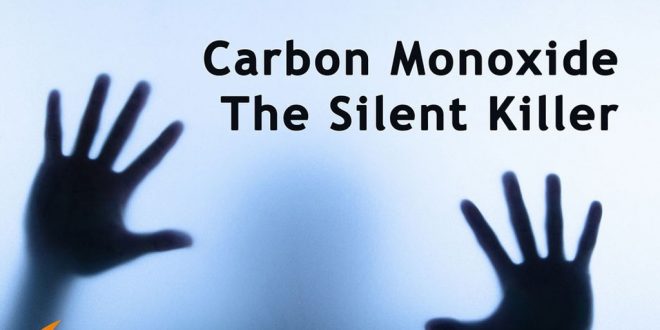
Carbon Monoxide Risk
Carbon monoxide is a colorless, odorless, tasteless toxic flammable gas formed by incomplete combustion of carbon.
Sources of carbon monoxide in a home:Fossil-fuel burning heaters, appliances, and fireplaces, or an attached garage.
Carbon monoxide poisoning is the second leading cause of death in the United States of non-medical poisonings.
[Source: http://www.ncsl.org/research/environment-and-natural-resources/carbon-monoxide-detectors-state-statutes.aspx]Because carbon monoxide is colorless and odorless, you won’t know it’s in the air without a carbon monoxide detector.
How does carbon monoxide poison the body?
According to the Mayo Clinic:
“Carbon monoxide poisoning occurs when carbon monoxide builds up in your bloodstream. When too much carbon monoxide is in the air, your body replaces the oxygen in your red blood cells with carbon monoxide. This can lead to serious tissue damage, or even death.
Carbon monoxide is a colorless, odorless, tasteless gas produced by burning gasoline, wood, propane, charcoal or other fuel. Improperly ventilated appliances and engines, particularly in a tightly sealed or enclosed space, may allow carbon monoxide to accumulate to dangerous levels
.
If you think you or someone you’re with may have carbon monoxide poisoning, get into fresh air and seek emergency medical care.
Symptoms:
Signs and symptoms of carbon monoxide poisoning may include:
Dull headache
Weakness
Dizziness
Nausea or vomiting
Shortness of breath
Confusion
Blurred vision
Loss of consciousness
Carbon monoxide poisoning can be particularly dangerous for people who are sleeping or intoxicated. People may have irreversible brain damage or even die before anyone realizes there’s a problem.”
[Source: https://www.mayoclinic.org/diseases-conditions/carbon-monoxide/symptoms-causes/syc-20370642]Features and Ratings of Carbon Monoxide Detectors:I suggest you search online for the features and ratings of the various types of carbon monoxide detectors.Otherwise, anything I write now may be out of date by the time you read this.
Laws requiring carbon monoxide detectors.The laws regarding requirements for installation of carbon monoxide detectors are created by state government, so vary from state to state.I suggest you search online for the laws requiring carbon monoxide detectors in your state.
Keep in mind that the laws may differ according to when your home was built and whether you occupy it yourself or rent it.
As an example, here are current laws [as of February, 2019] for North Carolina.
For owner occupied homes,
“R313 – Carbon Monoxide Alarms in One-and-Two-Family Dwellings and Townhouses Code: 2009 NC Residential Code Date: April 1, 2011
Section: R313 The North Carolina Building Code Council approved an amendment to the 2009 NC Residential Code that revises Section R313 to require the installation of carbon monoxide alarms in new and existing one-and-two-family dwellings and townhouses. The amendment has an effective date of January 1, 2011 and reads as follows:
R313.1.1 Carbon monoxide alarms. In new construction, dwelling units shall be provided with an approved carbon monoxide alarm installed outside of each separate sleeping area in the immediate vicinity of the bedroom(s) as directed by the alarm manufacturer.
R313.1.2 Where required-existing dwellings. In existing dwellings, where interior alterations, repairs, fuel-fired appliance replacements, or additions requiring a permit occurs, or where one or more sleeping rooms are added or created, carbon monoxide alarms shall be provided in accordance with Section 313.1.1.
R313.1.3 Alarm requirements. The required carbon monoxide alarms shall be audible in all bedrooms over background noise levels with all intervening doors closed. Single station carbon monoxide alarms shall be listed as complying with UL 2034 and shall be installed in accordance with this code and the manufacturer’s installation instructions.”
[Source:https://www.ncdoi.com/OSFM/Engineering_and_Codes/Documents/Interpretations3/2009%20Residential/R0313%20-%20Carbon%20Monoxide%20Alarms.pdf.]The law for rental properties is more strict, disregarding when the rental property was built:
N.C. Gen Stat. § 42-42 to 42-44 – Landlord and Tenant Articles – Residential Rental AgreementsRequires landlords to provide one operable carbon monoxide detector per rental unit per level.A landlord that installs one carbon monoxide detector per rental unit per level shall be deemed to be in compliance with standards under this subdivision covering the location and number of detectors. The landlord shall ensure that a carbon monoxide detector is operable and in good repair at the beginning of each tenancy. Failure of the tenant to replace the batteries as needed shall not be considered as negligence on the part of the tenant or the landlord.This subdivision applies only to dwelling units having a fossil-fuel burning heater or appliance, fireplace, or an attached garage.
What ever the laws are in your state, I urge you to install and maintain in good condition a carbon monoxide detector in your home or rental.The cost will be at/under $100.This is a small cost to prevent loss of life.You do not want your family and friends living with grief at your unnecessary death.You do not want to live with grief at the loss of a loved one or the burden of living with the knowledge that a small purchase on your part would have prevented someone’s death.Do it!
